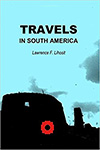Review — TRAVELS IN SOUTH AMERICA by Lawrence Lihosit (Honduras)
Rob Thurston (Venezuela 1968–70; staff: Belize, Honduras 1972–77 ) wrote . . .
I recently read Lawrence Lihosit’s book Travels in South America and submitted a review on Amazon.com. I liked the book a lot, having been to many of the places he, his wife and sister-in-law traveled to in 1988. My late wife (Juanita Thurston (Venezuela 1968-70) and I took a similar trip right after our Peace Corps assignment in Venezuela (January 1970), then returned to work and live in Bolivia with USAID from 1980-85, just before Lawrence made his trip. Consequently, the account resonated with me.
•
 Travels in South America
Travels in South America
by Lawrence F. Lihosit (Honduras 1975–77)
CreateSpace
Dec 2017 – second edition
418 pages
$22.95 (paperback)
This is not your normal travelogue, and once opened its hard to put down.
In 1988 Lawrence Lihosit, his Mexican wife, Margarita, and sister-in-law, Licha, take the reader far beyond notable sites and historical events encountered as they traveled on the cheap for six month to six countries —Ecuador, Peru, Bolivia, Argentina, Uruguay and Chile — and back to Mexico. Being fluent in Spanish, and with Lawrence’s nose for economizing, they travel light and linger wherever they get to know interesting local people and their storie and find good cheap foods . . . one of Lawrence’s concerns.
The dynamic between the two sisters and Lawrence comes through too — he is often outvoted two-to-one on travel and budget decisions. Against this backdrop, Lawrence and Margarita try diligently and, one might say religiously, to get pregnant.
If you have ever traveled on local buses, crossed borders on foot with a backpack, and stayed in often-grim backstreet hotels, you’ll immediately identify with this story. If you haven’t, you’ll be opened up to a whole new world without the countless inconveniences. Their stay in the remote eastern Bolivian lowland town of Trinidad and Lihosit’s account of a side-trip to an out-back cattle ranch is unbelievable and unforgettable; probably worth the read in its own right.
Lawrence’s real interest is in the often ordinary and sometimes extraordinary people they happen upon, many whom he interviewed for this book. These include a fascinating Mexican priest in Quito involved in the reconstruction/rehabilitation of a major cathedral and its secret religious art trove, and urban planners, artists, musicians, a traditional medicine man, poets and writers . . . and many regular folks, some struggling to overcome bad luck, bad choices and political persecution, others finding hope and satisfaction in their lives.
Lawrence’s group comes face to face with real differences in country specific and regional cultures, despite the common language and colonial past found in most areas. This is particularly felt in Peru and Bolivia where Quechua and Aymara cultures remain strong. They also experience the military presence, i.e. armed check points and military on the streets in Chile and Peru, and the sense of openness felt elsewhere. Some cultural perceptions are given a Mexican versus US interpretation, given the travel partners’ nationalities. Along the way, the group inevitably meets fellow travelers from around the world, often adding further cultural twists to the experience.
In sum, this is much more than a travel book about places. It is also an exploration of personal dynamics as well as of intriguing personalities and life experiences drawn from a big swathe of the South American continent.
•
Thanks to Rob- again.